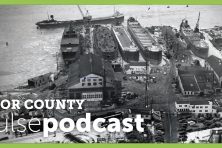Looking Inside the Sales Tax Numbers
- Share
- Tweet
- Pin
- Share
As regular readers know, I enjoy looking at numbers and statistics and then extrapolating trends, themes, or truths whenever possible. One set of numbers I regularly track in this column is the county sales tax figures. These figures are derived from that half percent sales tax Door County (and most other counties in Wisconsin) charges. Merchants, innkeepers, restaurateurs, etc. collect this tax and submit it to the state (along with the state sales tax of 5 percent), and the state redistributes the county tax portion back to the appropriate county. These distributions can be found – broken down by county – on the Wisconsin Department of Revenue’s website.
One of the things that is important to keep in mind when you look at these distributions is that the total for any month reflects exactly what was collected during that month. Each individual merchant (or innkeeper, or restaurant owner, etc.) may have differing deadlines for when the tax is due to be paid (i.e. monthly, quarterly, etc.). Thus, comparing January 2010 to January 2009, for instances, doesn’t provide any clear indication of an individual county’s economic health.
Looking at a broader picture of county sales tax collections, however, can provide at least some indication of the economic health of a county.
You may remember that by the end of 2009, Door County sales tax collections were down approximately $266,000. When you do the math, this meant that approximately $53 million less was spent in Door County in 2009 compared to 2008. This figure was later confirmed by the state of Wisconsin when they issued their report on tourism spending in 2009.
There is really no positive way to look at a decrease of that magnitude, particularly in a largely insulated economy like the Door Peninsula. Nonetheless, I tried to be optimistic in conversations with other business owners this past winter. If you accept the Door County Visitor Bureau’s projection of 2 million visitors to Door County this year, all we require is that each visitor spend $25 more than a visitor spent last year during their stay. In other words, if each couple spent an additional $50, and each family of four spent an additional $100, that would equal $50 million more spent on the peninsula – thereby recouping most of what we lost last year.
Of course, for most of us, expenses have increased, so returning to the 2008 levels of spending in the county would still leave finances tighter than they were in 2008, but at least we would be trending in the right direction.
So, with all of the above as background we come to the county sales tax figures for this year. As of this column, the Wisconsin Department of Revenue has posted the county sales tax distributions through June of this year, so we have a snapshot of where Door County stands through the first half of this year. The table below shows the county sales tax distributions from January to June for the past four years. Remember that comparisons between individual months are not particularly relevant and that what really matters are the totals at the bottom of each column.
Unfortunately, not only are visitors not spending the additional $25 per person I so optimistically outlined above, they are actually spending less than they spent in 2009. Indeed, Door County’s sales tax collections through June of this year are down $32,346.44, or about 3 percent, from 2009. And when you do the math, this means that spending on the peninsula is already down $6,269,288 from the same time last year.
When you look at the broader four-year span, you see that county sales tax collections have steadily decreased. In fact, if you compare the first half of this year to the same period of time in 2007, the decrease is $126,353.22, or 11 percent. And that translates into $25,270,644 less spent in the first six months of 2010 than in the first six months of 2007.
There are many reasons, of course, for these dramatic drops; most notably the struggles of the national economy. Still, according to the figures kept by the Door County Tourism Zone Commission, the hospitality industry was off just fractionally last year and has been performing adequately this year. So, if hospitality is roughly holding its own in this economy and the county sales tax revenues are continuing to slide, this illustrates just how poorly the other industries that collect the tax – most notably retail and restaurants – are performing.
All we can do now is wait to see where things stand after the end of the season in October.

